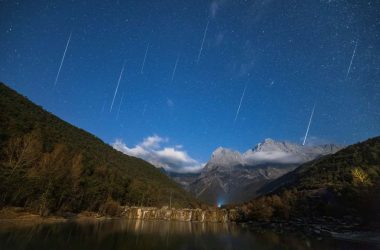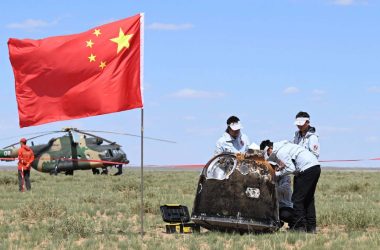A 4-metre-wide crater caused a course correction
ISRO
India’s moon rover has successfully avoided a small crater and continued to explore uncharted territory near the south pole. Meanwhile, its mothership lander has transmitted its first scientific data as the Chandrayaan-3 mission reaches its halfway point.
After the Indian Space Research Organisation (ISRO) spacecraft landed on August 23, the six-wheeled Pragyan rover, weighing just 26 kilograms, rolled off the Vikram lander and onto the lunar surface once the sun had risen at the landing site. The rover stayed near the lander while ISRO engineers performed tests and waited for its solar panel to start generating power. On August 27, Pragyan encountered a 4-metre-wide crater, leading to a change in direction. The rover is now “safely heading on a new path,” tweeted ISRO on August 28.
The Chandrayaan-3 mission has also provided its first valuable scientific data. The lander’s device called ChaSTE (Chandra’s Surface Thermophysical Experiment) measured the temperature of moon dust below the surface. At a depth of 20 millimeters, the temperature was approximately 40°C (104°F), but it rapidly dropped because moon dust is not a good conductor of heat. At a depth of 80 millimeters, the temperature reached -10°C (14°F).
This suggests the possibility of liquid or frozen water just beneath the surface, which has significant implications for future crewed missions. Water can be consumed by astronauts and used to create breathable oxygen and rocket fuel.
The Pragyan rover’s tracks on the lunar surface
ISRO
John Bridges, a researcher at the University of Leicester, UK, believes that due to the low pressure on the moon, it is unlikely to find liquid water near the surface, even in areas where the temperature is above freezing point. Water would boil away due to the low pressure, although at greater depths, the pressure might be high enough to support liquid water. However, it is too early to draw conclusions from the readings of Chandrayaan-3.
“But it’s fantastic they’re getting data,” says Bridges. “You can’t help comparing it to certain other space agencies; engineers are just getting on now and doing it. They’re sort of overtaking Russia.”
Both the lander and rover of the Chandrayaan-3 mission are expected to function for one lunar day, equivalent to 14 Earth days. Their operation is limited by sunset, which prevents them from gathering energy from solar panels, and by the extremely low temperatures that the equipment must withstand overnight, dropping as low as -238°C.
ISRO did not respond to a comment request, but mission operations director M Srikanth expressed confidence that the rover and lander will re-awaken after the lunar night ends.
“Our priority is to ensure that the project objective of obtaining scientific data for one lunar day is achieved. We are focusing on rover mobility and payload operations. This will continue for another seven days, after which the systems will go to sleep when the Sun sets,” said Srikanth. “So far, all indicators are looking good, and we are confident that the lander and rover will come back to life when the night ends. If that happens, it will be a bonus, and if not, the mission is still considered complete.”
If the hardware is not damaged by the cold, both the rover and lander are designed to utilize solar power, restart, and resume communication with Earth. The rover will be positioned before sunset to maximize its chances of achieving this when the sun rises again, according to Srikanth.
Topics:












